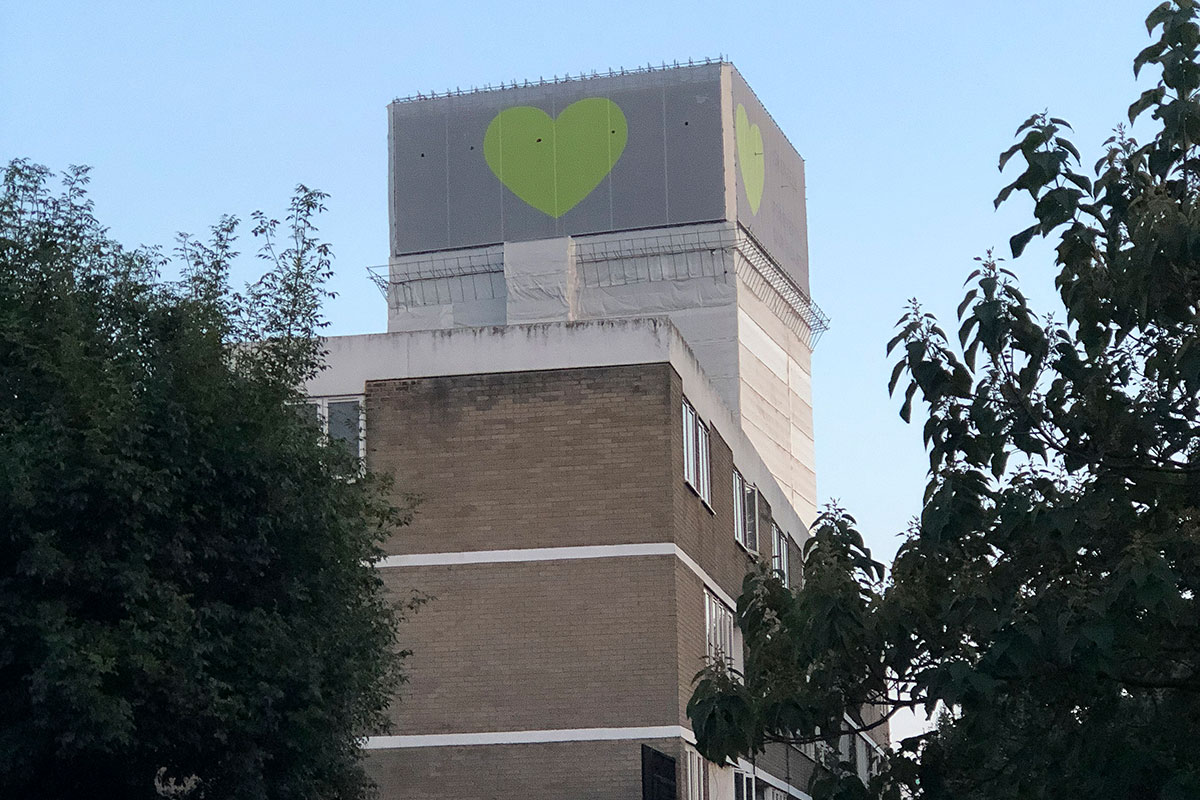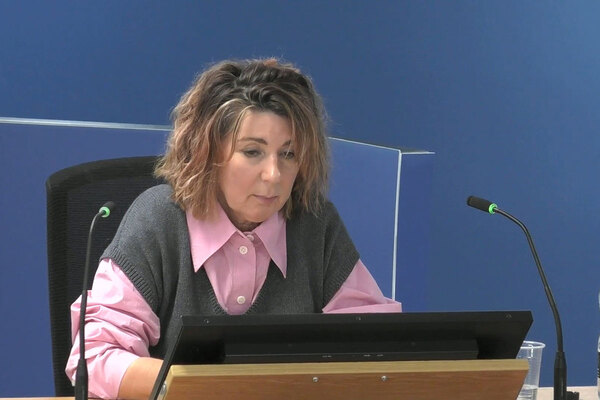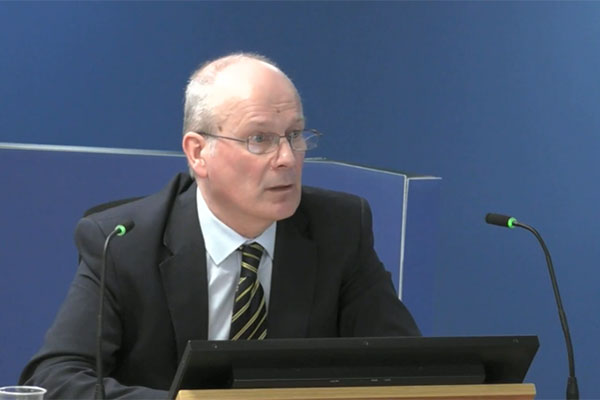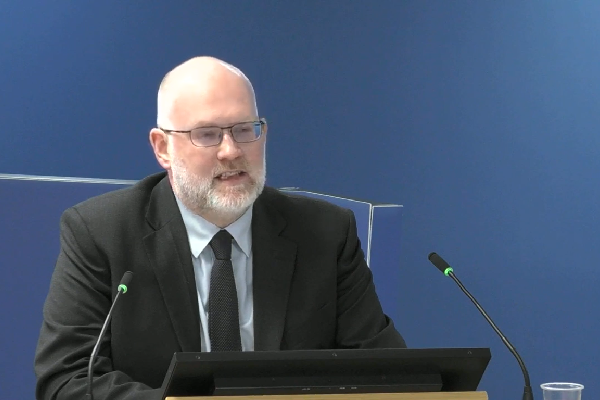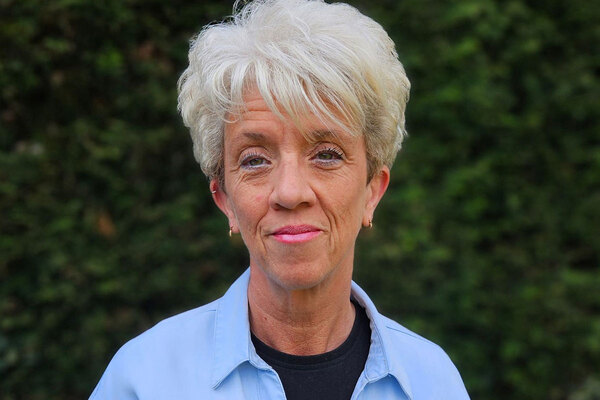Senior civil servant ignored ‘red alert’ warning about ‘widespread use’ of Grenfell-style cladding
A senior civil servant “ignored” a “red alert” warning about the “widespread, historic and ongoing” use of a highly combustible cladding product on UK high rises, despite explaining to colleagues only days previously how it would go “whoosh” if exposed to fire.
The Grenfell Tower Inquiry today saw emails from senior official Brian Martin that showed him explaining the danger posed by aluminium composite material (ACM) cladding to colleagues 18 months before fire ripped through the tower.
The inquiry heard that he never passed on warnings he received from industry about its widespread use to colleagues or ministers, instead assuring them that the material was not “a problem in the UK”.
Since the blaze, more than 450 high-rise buildings have been discovered in the UK with the highly combustible material, which has also been identified as the primary reason for the rapid spread of the fire at Grenfell Tower, which killed 72 people.
In a series of explosive emails released by the inquiry today, it was also revealed that Mr Martin, who still holds a senior role in government, told a colleague to “roll a turd in glitter” as he prepared to explain progress on an important but seriously delayed review of fire safety rules to ministers.
He also forwarded a document containing warnings about the “potentially fatal consequences” of weaknesses in the official guidance on fire safety to colleagues just hours before the outbreak of the Grenfell Tower fire in June 2017.
His covering email, which suggested that the document would soon be “shoved under the nose” of ministers, was described as “dismissive and casual to the point of being cynical”.
The revelations came as Richard Harral, the former head of technical policy in the building regulations division at the Department for Communities and Local Government (DCLG), gave a second day of evidence about the years leading up to the Grenfell fire.
He described his team as “beaten up” by the system in which they worked and said building regulations were “perennially marginalised” by a department that was primarily concerned with reforming planning, deregulating and boosting housing supply.
The inquiry saw emails between officials including Mr Harral and Mr Martin in February 2015 and January 2016 discussing major cladding fires in the United Arab Emirates, which had ripped through high-rise buildings clad in ACM.
In response to one such fire in February 2015, Mr Martin told his colleagues: “There are provisions in the building regulations designed to prevent this kind of problem, so this shouldn’t be a problem in the UK. There are of course no guarantees.”
He did not mention that just eight months earlier, an industry group had specifically warned him that passages in Approved Document B saying he intended to ban the use of this material were “not clear”, and that there were many products on the market that appeared to comply with the minimum standards.
The group, convened by the Centre for Window and Cladding Technology (CWCT), had encouraged Mr Martin to publish a ‘frequently asked question’ (FAQ) to make it clear that the cladding product should not be used in the UK.
Mr Harral accepted today that this would have been “a simple thing to do”.
Kate Grange QC, counsel to the inquiry, asked: “Can we also agree that once you knew about those events in Dubai… you should have been looking to make sure the guidance was crystal clear on this point?”
“I wish I had thought that way,” Mr Harral replied. “I think I had become very non-reactive because doing anything was so hard.”
“Wasn’t it just common sense to anybody looking at this information that it was screaming out for somebody to check whether we had this problem in the UK?” asked Ms Grange.
“In retrospect, of course, but we were so beaten down by the kind of structures that we sat within… that we were not feeling confident or adventurous or forward-looking,” Mr Harral replied.
A year later, in January 2016, following a similar fire also in Dubai, Mr Martin wrote to colleagues: “Nothing new here. The fire is most likely to be similar to several others that have hit Dubai in the last couple of years.
“It relates to a cladding product which is a laminate of aluminium and polyethylene… It’s very rigid and makes nice shiny buildings. Sadly when it gets exposed to a fire the aluminium melts away and exposes the polyethylene core. Whoosh!”
He went on to explain that a passage in official guidance requiring that ‘filler material’ be of ‘limited combustibility’ meant that this material was banned in the UK. But this was precisely the wording which the CWCT meeting had told him was “not clear”.
“He should have explained that this was an issue that had been rumbling on for some time and on which pretty authoritative bodies had raised concerns, shouldn’t he?” Ms Grange asked.
“I would have wanted him to, yes,” said Mr Harral, who repeatedly claimed to have had no knowledge of the uncertainty surrounding the guidance until after the Grenfell Tower fire.
A month later, as the inquiry has previously seen, Mr Martin was contacted by a cladding supplier and warned that ACM was being widely supplied for use on high-rise buildings in the UK.
The supplier, Nick Jenkins of Euroclad, warned that “there are many such buildings and their numbers are growing”. He wrote: “I do think the situation is of grave concern. Surely this justifies the requirement for a less ambiguous statement of the rules?”
Mr Martin told Mr Jenkins that the core of an ACM panel “could be considered filler”, but added: “If the designer and building control body choose to do something else then that’s up to them.”
Asked if he could explain why Mr Martin was “giving a different answer” to his definitive statement to colleagues that the product was banned, Mr Harral said he could not.
“[This] was plainly a life safety matter of the utmost importance which needed to be addressed urgently – a red alert situation. Do you agree?” Ms Grange asked.
“Yes, this should have been escalated,” said Mr Harral.
He said that the warning would have been raised with the directors of the department and ministers if Mr Martin had passed it along. But he accepted that this never happened before the fire at Grenfell Tower.
Asked if he agreed that Mr Martin “was warned in the clearest of terms that ACM PE products used in [the fires in the Middle East] were also on buildings in the UK”, Mr Harral said: “That seems very clear from the correspondence.”
He also agreed that Mr Martin was informed that the situation was “widespread, ongoing and historic”.
“Can you help us as to why these warnings were ignored by the fire safety lead in your department?” asked Ms Grange.
“I’m afraid I don’t… I just don’t understand,” Mr Harral responded.
“You can’t offer any explanation as to why he ignored these warnings?” Ms Grange asked.
“No, I can’t,” said Mr Harral.
The inquiry saw minutes of a further CWCT meeting in March 2016, where Mr Martin accepted that guidance on this point was “poorly written and open to interpretation”.
Mr Harral said that Mr Martin never told him he thought this.
The inquiry then saw that on the afternoon of 13 June, Mr Martin sent a document prepared by the Fire Sector Federation – a collective body of fire safety and built environment professionals – which collated the results of a survey of its members on Approved Document B.
The front sheet warned that the document was “out of date, placing businesses and communities all over the UK at potentially fatal risk”. Its survey results included the finding that 92% of members believed there was a need for changes to the regulations or guidance.
Mr Martin wrote at the time: “I expect our new minister [Alok Sharma, appointed following the 2017 general election] will have this shoved up his nose at some point soon.”
Ms Grange asked Mr Harral: “Do you agree that this email was dismissive and casual to the point of being cynical?”
“No, I just think it’s a turn of phrase,” Mr Harral replied. He described Mr Martin as “concise” and said he “expresses himself in a particular way”.
“Was this characteristic of his approach to fire safety concerns raised with him at this time?” asked Ms Grange.
“I don’t believe so,” Mr Harral replied.
“Was this characteristic of your division’s attitude to fire safety at this time?” she added.
“I don’t believe so. All I can do is apologise,” Mr Harral said.
Earlier, the inquiry saw emails exchanged between Mr Martin and Mr Harral as they sought ministerial approval to begin a review of Approved Document B in March 2016.
This related to a long-delayed review of the document that had been promised to the coroner investigating the six deaths caused by the 2009 fire at Lakanal House three years earlier.
Mr Harral suggested making changes to the discussion document, proposing the redrafting process that would go to minister Gavin Barwell to show that “we haven’t been sitting on our hands”.
“I’m pretty sure the department’s upper echelons have been sat on my hands for the last 18 months,” Mr Martin replied.
“They are not even aware you have hands to sit on,” Mr Harral wrote in response. “Let’s just agree to gild lilies where necessary.”
“You can roll a turd in glitter if it gets us moving,” Mr Martin said.
At the inquiry, Ms Grange said: “One interpretation of this is that what he meant was what you had achieved so far was akin to a turd, but you would have to dress it up and persuade them you had done more work than you had actually done.”
Mr Harral said this was not the case, adding that he believed Mr Martin was simply encouraging him to “do whatever you have to do to get things going”.
The inquiry saw that the document which ultimately went to Mr Barwell’s office did not make it clear that the review was delayed, or that a promise had been made to publish a new version of the guidance by 2016-17.
“There’s nothing in those documents which indicates that this document has been years in the making and is now delayed to the point of embarrassment and that he needs to get on top of this urgently,” Ms Grange said.
Mr Harral said this was partly because the delay had been caused by Mr Barwell’s own office focusing only on issues relating to the recently published Housing White Paper.
“So what I’m trying to say is that at least five months of the delay was down to decisions made in Mr Barwell’s private office and it would be quite destructive to our relationship with that private office if we started pointing fingers,” he said.
He told the inquiry that building regulations were “perennially marginalised” within the department in favour of planning policy and deregulation.
“I was starting to think there was a concerted effort to slow this process down so that we would be available to go into another cycle of pure deregulation,” he said.
He said that across the portfolio of issues he was responsible for, “there is very clear evidence of failure” in many areas, but it was difficult to address them all.
“I think what I’m trying to say is that the system as a whole, the entire way that it was structured, was inherently unresponsive and that was exacerbated by the economic policies that you had,” he said.
Mr Harral quit the civil service in late 2017, and has told the inquiry that he was suffering from stress-related illnesses resulting from his work.
Asked at the end of his evidence what he would have done differently, he said: “I deeply regret my failings that have been exposed by the evidence we have heard and I can only apologise to the victims and their families and all who have been affected.
“I’m deeply ashamed of the part I have played in this absolute tragedy and I hope we can learn key lessons about the regulatory culture we have in this country.
“I hope we can learn about the need to temper our obsession with innovation and the predominance of economic theory over more pragmatic human concerns and I hope we end up with an industry that actually is serving the people it aims to deliver for in a way that keeps them safe.”
The inquiry continues.
Sign up for our weekly Grenfell Inquiry newsletter
Each week we send out a newsletter rounding up the key news from the Grenfell Inquiry, along with the headlines from the week
Already have an account? Click here to manage your newsletters
